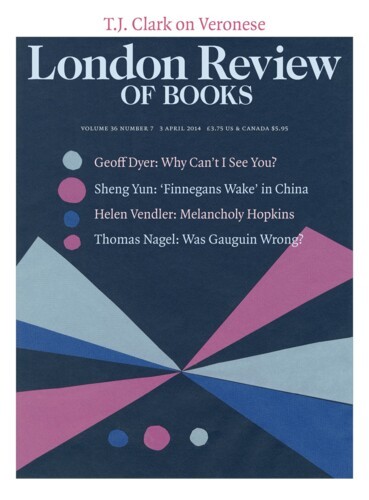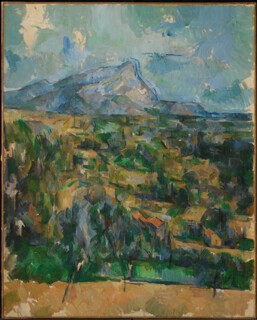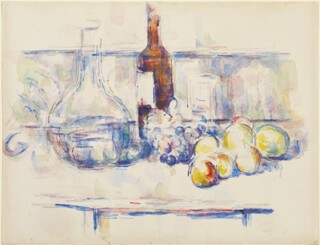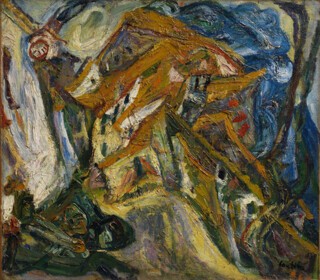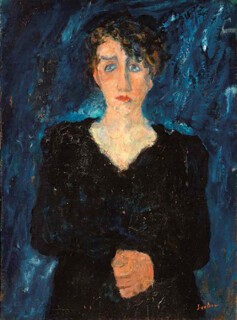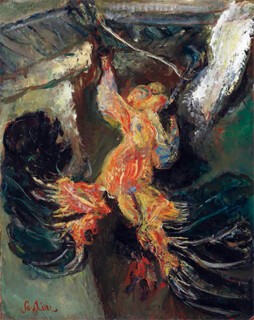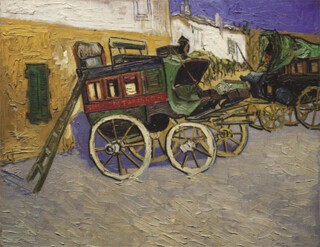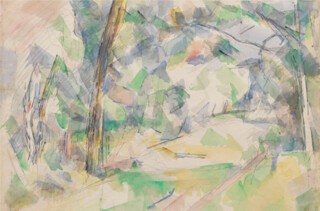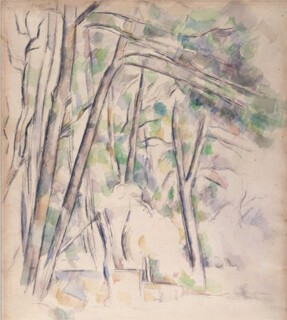If you want to pick a quarrel with Cézanne, Cézanne and the Modern at the Ashmolean provides cues. Take his own quarrel with lines. Cézanne walks into the woods with a sheet pinned to a board. A tree trunk heads upwards, reaching for light. Cézanne’s pencil follows it. There is a line in nature and now there is a line on the sheet. But no, that won’t do. Stuff buffets the line sideways, Cézanne decides: here it will have to fall back, breaking like a rank under fire; and there, hatchings and dabs of wash must push the front forward. What stuff? ‘More nature’ might be one answer: the sunlight and foliage among which the trunk rises up. That would be an Impressionist answer, insofar as Impressionists believed in ambiences rather than bounded bodies. But with Cézanne, the sheet itself is trumps. Every challenge to the paper’s continuity must be checked. Clean verticals threaten its integrity: chop them, skew them. So much for the tree trunk and where it wanted to go.
On a tabletop shared by grapes, apples and a wine bottle, a shapely carafe gives up the ghost in a shudder of halations. The grapes likewise dematerialise, floating free of the sheet like the ‘grin without a cat’ in Alice in Wonderland. This still life and the tree studies are sheets worked far away from Paris by a solitary man in late middle-age, yet what high-pitched melodramas he enacts. Slow, tremulous and precious, his disposition of strokes and dabs across the paper: a tree-arch forms a private proscenium within which four sharp and radiant colours perform a geometrical ballet. And yes, the arch interests Cézanne with its topological promise, the distinctive type of space it asks him to inhabit, in much the way that fruit interests him, or Mont Sainte-Victoire. Interest generates pleasure and there’s no quarrelling with that. But it remains the generic interest of an aesthete on the prowl for stimuli, and the trust he keeps is not with this or that made thing – hill, tree or bottle – but with the paper’s glow, with a big bright latency that represents the cause of art.
The 18 works on paper and six canvases by Cézanne on show at the Ashmolean (until 22 June) come from an American collection, other items from which – a Van Gogh, a Degas and a Sisley – help put them in historical focus. Vincent turns a streetcorner in Arles and encounters the old stagecoach from Daudet’s Tartarin de Tarascon, a favourite novel: he seizes the moment and paints its portrait. He even scrawls its destination on its flank. How salutary it is to be thrust back – brutally, with all the vehemence of Van Gogh’s ‘high yellow’ summer of 1888 – into a world of names, meanings and products that have forms, functions and histories. How chilling it is, in the wake of this, to enter the innermost sanctum of Parisian aesthetics, the studio where Degas mulls over his nude studies, recomposing them on a large canvas into an airless and majestically sardonic artifice, a rear view of a contorted girl that samples and overdubs the retreating echoes of his own erotic interest. Degas and Cézanne, these rentier-researchers with their expansive resources of paper and canvas, have risen above the modest creed on which the Impressionist Sisley still relies, setting his easel before water and poplars: among nature’s endless rhythmic flux, one bounded object must still persist, the properly resolved artwork.
Artworks are narrow while art is broad. You catch glimpses here of the outward flow. The Gauguin of 1889 still dreams of well-resolved figurines, so a haunting little clay effigy suggests, whereas by 1897 he is a performance artist putting out bad-boy bluster – a lewd, crude nameplate for his Tahiti bungalow – to wind up the colonial missionaries. These glimpses are from a strange sideways vantage. Henry Pearlman, the cold storage magnate whose collection has been transported to Oxford, got to know modern art backwards: his first serious purchases in the 1940s were of Ecole de Paris work from two decades earlier, and it was only later that he reached out for Manet and Daumier. He steered clear of Cubism and let go of a major Matisse (Bathers by a River, 1917), which suggests that he was his own man, no weathervane. As a result, Cézanne and the Modern presents an awkward sort of ‘modern’.
There are some fey Modiglianis and some bombastic Lipchitz bronzes, but the 20th-century section is dominated by Soutine, with three large paintings of the village of Céret, three portraits and a quasi-crucifixion, in which a splayed plucked turkey dangles from a butcher’s hook. Soutine claws and clings to the age-old idea of an artwork: an icon suffused with content, a proposition aimed at an altar rather than at some gallery vernissage from this modern aesthetical age. (These instincts mean that here in Britain, we can’t help but view Soutine through Francis Bacon spectacles.) A nameless Parisienne occupies a 1929 canvas in hieratic centrality, and yet the paint textures here are mobile and deep: her sad eyes summon from Soutine a performance as respectful of European high tradition as anything in 20th-century portraiture. Packing the whole of Céret into a canvas, however, Soutine’s ambitions for the picture accelerate, skid and explode. He requires it to deliver everything, everywhere, at once – to be at once the roadmap and the tarmac. The only means to the end turns out to be thrash, ‘bad’ painting.
And so Soutine falls in with that noble refrain of modern aesthetics, the triumph of failure. As Scott Allan (citing Richard Kendall) remarks in a catalogue essay, Degas had been among the notion’s pioneers. The heart of this show is impossibility – ‘Will I reach the goal I’ve sought so hard?’ as Cézanne lamented – at its most mythically triumphant, a Mont Sainte-Victoire canvas painted shortly before his death. It’s a melodrama of the innocent eye – let nameless thereness become nameless paint! – and what it has to do with truth, I’m not sure. But certain myths prove too grand to resist for long.
Send Letters To:
The Editor
London Review of Books,
28 Little Russell Street
London, WC1A 2HN
letters@lrb.co.uk
Please include name, address, and a telephone number.
